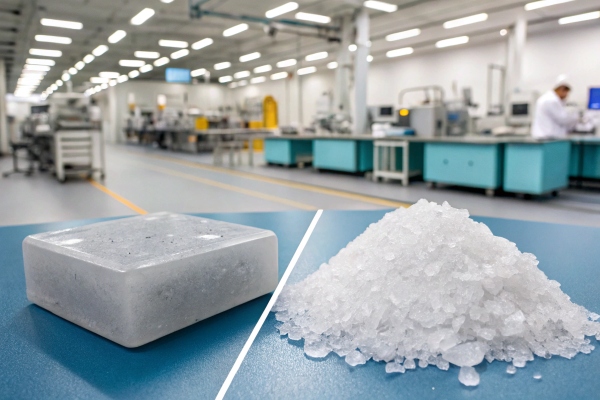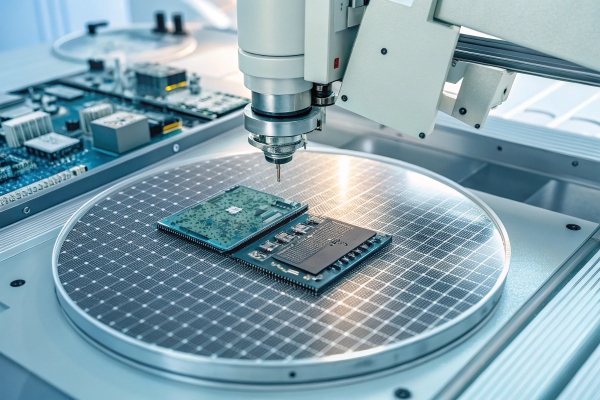Have you ever wondered whether silicon and silicone are the same thing? Many people assume they're interchangeable, but they’re actually quite different. Let’s explore the distinctions.
Silicon is a natural element, while silicone is a synthetic polymer made from silicon. Though they sound alike, their uses and properties are worlds apart.
This confusion is common, especially in industries where both materials play crucial roles. Let’s break down how they differ and their specific uses.
Are silicon and silicone the same?
Are you still unsure whether silicon and silicone are the same? Let’s take a deeper look to clear up any confusion.
No, silicon and silicone are not the same. Silicon is a chemical element, while silicone refers to a family of synthetic materials made from silicon mixed with oxygen, carbon, and hydrogen.
Silicon: The Element
Silicon is a naturally occurring element found in the Earth's crust. It’s most commonly used in electronics1 and construction, like in the production of semiconductors2, solar panels, and concrete. Silicon is known for its strength and conductivity.
Silicone: The Material
Silicone, on the other hand, is a man-made material that includes silicon but has been altered to include oxygen, carbon, and hydrogen. This transformation gives silicone its unique properties, like flexibility, durability, and resistance to heat, making it suitable for use in medical devices3, cookware, and rubber seals.
What is the most common use for silicon?
Silicon might seem less versatile than silicone, but it has plenty of uses, especially in high-tech industries.
The most common use for silicon is in the electronics industry, where it’s used to create semiconductors for computers, smartphones, and solar panels.
Silicon in Electronics
Silicon plays a key role in electronics, especially in microchips4 and transistors. Its ability to conduct electricity in a controlled manner makes it the go-to material for the tech industry. Without silicon, modern gadgets and computers wouldn’t exist.
Silicon in Solar Panels
Silicon is also crucial in solar technology5. It is used to manufacture photovoltaic cells that convert sunlight into electricity, which helps make renewable energy more accessible.
How does silicon turn into silicone?
Silicon’s transformation into silicone is quite fascinating. It involves a chemical process that gives silicon new properties, making it usable in everyday products.
Silicon turns into silicone through a process of polymerization6, where it’s combined with oxygen, carbon, and hydrogen to form a flexible, heat-resistant material.
The Process of Polymerization
To create silicone, silicon is combined with various elements through a polymerization process, where small molecules bond together to form a larger, more complex structure. This transformation gives silicone its desirable properties, like flexibility, water resistance, and heat resistance.
Applications of Silicone
Once transformed, silicone becomes a versatile material used in a range of industries, from healthcare to cooking to automotive manufacturing.
Is silicone a rubber or plastic?
If you’ve ever wondered whether silicone is considered rubber or plastic, you’re not alone. Let's break it down.
Silicone is technically neither rubber nor plastic but is often referred to as a “rubber-like” material. It shares some properties with both, such as flexibility and durability, but is chemically distinct.
Silicone as a Rubber-Like Material
Silicone has similar qualities to rubber, such as elasticity, but it’s made from a different set of materials. It’s often used in rubber seals, gaskets, and other flexible components due to its resistance to extreme temperatures and UV radiation.
Key Characteristics of Silicone
Composition: Silicone is made from silicon, oxygen, carbon, and hydrogen. Its unique molecular structure consists of silicon-oxygen chains, which differs from the carbon-based backbones typical of most plastics.
Properties: Silicone exhibits high thermal stability, flexibility, and resistance to environmental factors. It can withstand extreme temperatures ranging from -60°C to 230°C (-76°F to 446°F), making it suitable for various applications.
Classification: While silicone shares some characteristics with rubber, such as flexibility and durability, it is technically a synthetic rubber. It is often referred to as a silicone elastomer due to its specific properties that align with both rubber and polymer classifications.
Comparison with Plastic
While silicone is flexible like rubber, it is not a plastic. Plastic is typically made from petroleum-based polymers, while silicone is a synthetic material derived from silicon. Silicone is more durable and can withstand higher temperatures than most plastics.
Durability: Silicone is generally more durable than many plastics and can resist weathering, flame, and steam. In contrast, traditional plastics like PVC may be better suited for chemical resistance.
Recyclability: Silicone can be recycled but typically requires specialized facilities for processing. It does not break down into microplastics like some conventional plastics do.
Silicone is best characterized as a synthetic rubber or elastomer that possesses unique properties distinguishing it from both traditional rubber and plastic materials.
Is silicone safe for humans?
Safety is always a priority, especially when it comes to materials used in daily products. Is silicone safe for human use?
Yes, silicone is considered safe for human use. It’s non-toxic7, hypoallergenic, and often used in medical devices and kitchenware without any harmful effects.
Silicone in Medical Applications
Silicone is widely used in medical devices like breast implants, catheters, and tubing because it’s biocompatible, meaning it won’t cause harm or irritation when in contact with the body.
Silicone in Food and Cookware
Many food-grade products, such as baking mats, spatulas, and baby bottles, are made from silicone because it’s resistant to bacteria and mold, making it safe for use in food preparation.
Conclusion
In conclusion, while silicon and silicone share a common name, they are distinct materials with different properties and uses. Silicone is a safe, versatile material with a wide range of applications, from electronics to healthcare.
Footnotes:
-
This article explains the role of silicon in solar panels and how it helps convert sunlight into electricity, a key use in renewable energy. ↩
-
Silicon is the key element used in semiconductor manufacturing, which is crucial for modern electronics like microchips and transistors. ↩
-
Silicone’s biocompatibility makes it suitable for use in medical devices and food-grade products, ensuring safety for human contact. ↩
-
Learn more about the role of silicon in microchips, which are essential for most electronic devices. ↩
-
Solar technology is a way to convert sunlight into energy, which can be used to generate electricity or stored in batteries. ↩
-
The polymerization process is critical in transforming silicon into silicone, a versatile material used across multiple industries. ↩
-
Silicone is non-toxic and hypoallergenic, making it a safe choice for medical and culinary applications. ↩










